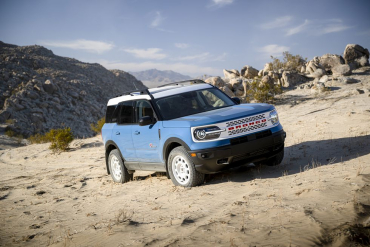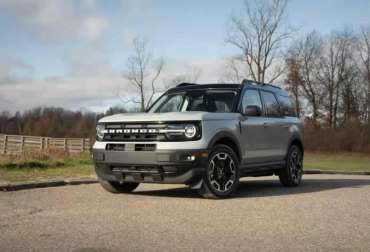Displaying items by tag: Ford Bronco Sport
2023 Ford Bronco Sport Heritage Editions Play the Retro Card
With or without its wayback garb, this baby Bronco remains impressively capable.
Ford continues to channel the rich history of its iconic Bronco 4x4 with the introduction of two new retro-inspired special editions of its compact Bronco Sport SUV.
The 2023 Bronco Sport Heritage Edition and Bronco Sport Heritage Limited Edition celebrate the birth of the Bronco brand with a classic-themed appearance package that takes styling cues from the original 1966 truck. Both variants feature a white roof, white rear badging, white 17-inch aluminum wheels, and a white grille with red BRONCO lettering.
The Bronco Sport Heritage Edition, built on the Big Bend trim level, utilizes Ford's 181-hp turbocharged 1.5-liter inline-three, which is paired with an eight-speed automatic transmission and all-wheel drive. Suspension features include hydraulic front bump stops and specially tuned springs included in Ford’s High-Performance Off-Road Stability Suspension (HOSS) system package, plus five user-selectable "G.O.A.T." terrain modes for off-road driving.
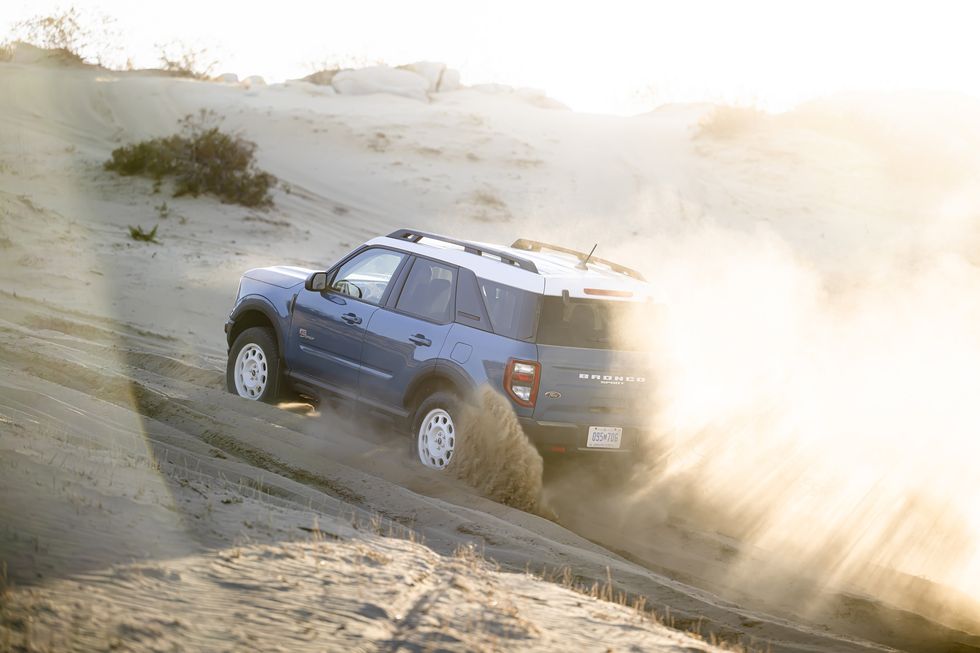
The Heritage Edition's interior styling includes white trim accents, plaid cloth seats, blue-and-red accent stitching, a microsuede center console armrest, and Navy Pier Blue accents on the door panels and dash. Buyers have a choice of seven paint options, including Robin's Egg Blue, a throwback color based on one that was available on the original Bronco.
The pricier Heritage Limited Edition is derived from the Bronco Sport lineup's more off-road-focused Badlands package, which features the larger turbocharged 2.0-liter inline-four, two additional G.O.A.T. modes, a torque-vectoring rear differential, and a lockable center clutch pack for the all-wheel-drive system. Our Peak Blue sample is one of three paint shades available, the others being the lighter Robin's Egg Blue and the intense Yellowstone Metallic.
Heritage Limited Edition–specific features include larger 29-inch all-terrain tires, leather-trimmed seats, and white door inserts. A retro-style plaque adorns the center console, while metal Bronco door badging in the classic '60s script is satisfyingly eye-catching.
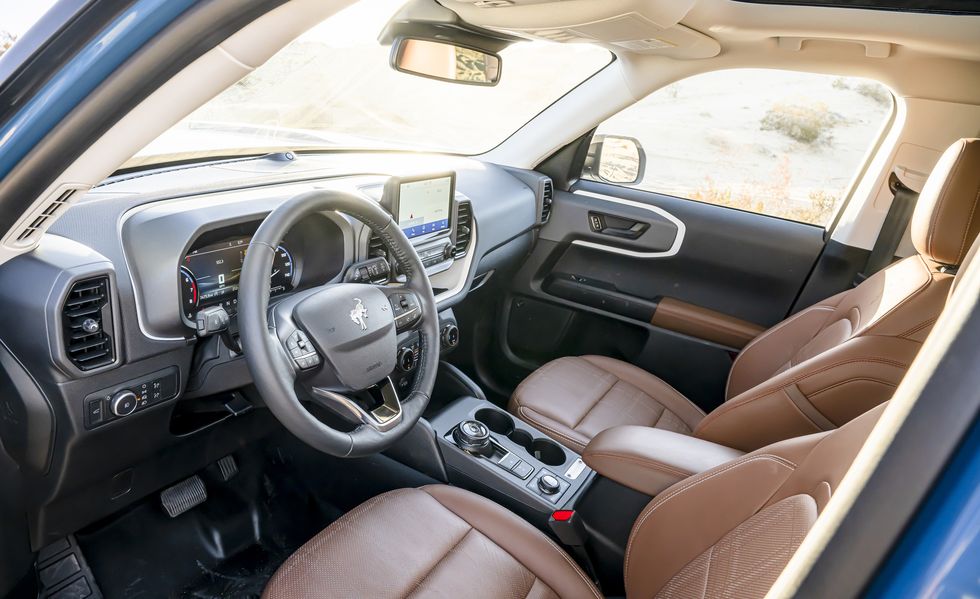
Despite its basis in the humble C2 unibody platform as used in the Escape SUV and Maverick pickup, the Bronco Sport proves to be unexpectedly capable off-road, with the 2.0-liter's 250 horsepower and 277 pound-feet of torque making light work of the steep gullies, embedded boulders, and deep sand that constitute the Johnson Valley area of the Mojave Desert. (So much of the model's off-road development was conducted here that Ford chose to include a geographic coordinate from the area as an Easter egg hidden in the molding of the rear hatch trim.)
An aluminum skid plate, part of the standard Badlands equipment package, eases concerns of stabbing the Bronco Sport's underbody with spiky terrain elements. Despite the Sport's modest ride height, its 8.8-inch ground clearance (on 235/65R-17 tires, the model's largest available) proves to be perfectly adequate for comfortably brisk-paced desert driving as we follow the dusty wake of our guide, Melissa. She is well-versed in the Bronco Sport's abilities, having taken a stock Bronco Sport Badlands to first place in the 1500-mile, off-road Rebelle Rally in both 2021 and 2022.
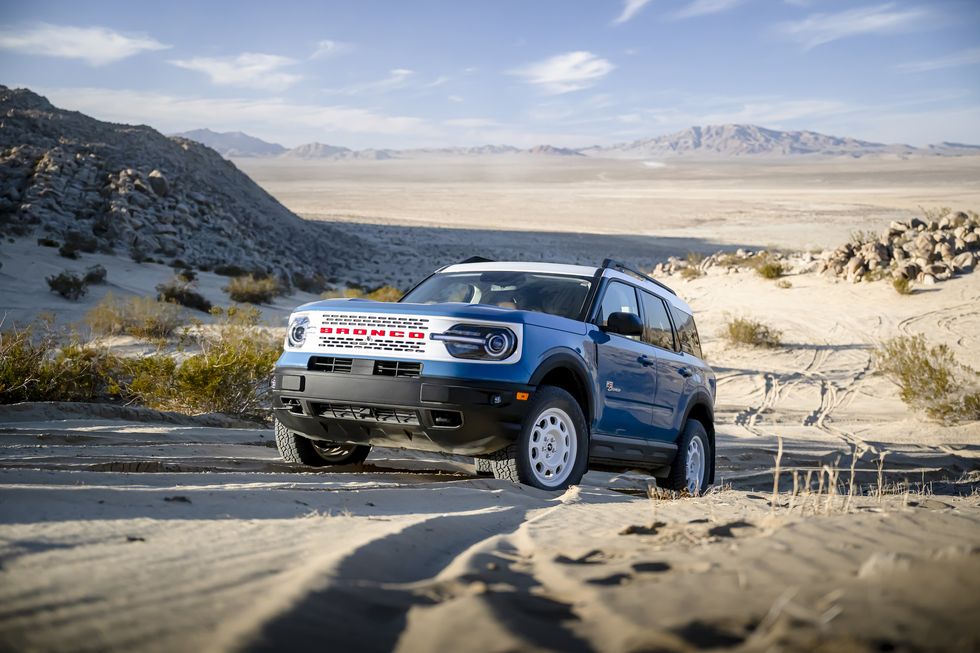
It is the suspension that makes the Bronco Sport, and despite the plethora of off-road driving modes available, this SUV handles even soft trail running just fine in its standard drive mode. Locking in the all-wheel-drive system and the rear differential is more than sufficient for confident thrashing in deeper sand.
All of that would be equally true for the less retro-tastic Badlands model, however. At $46,250, the Heritage Limited Edition is fully kitted out, carrying nearly $5000 worth of features that are optional on the Badlands. Screen that out, and you see that the retro look carries a roughly $2000 premium. One rung down, the $34,245 Heritage Edition represents a roughly $1500 upcharge over the equivalent Big Bend model.
Is that worth it? Well, several miles east of where we drove this Bronco Sport, classic Broncos, stock and modified, are swarming the viewing areas of this year’s King of the Hammers desert road-race competition. For off-road enthusiasts, the appeal of those classic Broncos, the reborn Bronco, and this offshoot Bronco Sport is wrapped up in the combination of capability and aesthetics. The Bronco Sport Heritage Editions lean more heavily on the latter, but to no detriment of the former.
2021 Ford Bronco Sport Review: Who Ordered the Budget Land Rover?
The verdict: This Ford’s combination of on-road manners, genuine off-road ability, slick interior designs and rugged good looks make it a Land Rover for budget-minded buyers.
Versus the competition: The only compact SUV that comes close to what the Bronco Sport can do is the “trail-rated” Jeep Cherokee Trailhawk, and even then, the Bronco costs less. Other compact SUVs might have more interior room, but they’re really meant only for on-road driving, not cross-country adventures like the Bronco Sport.
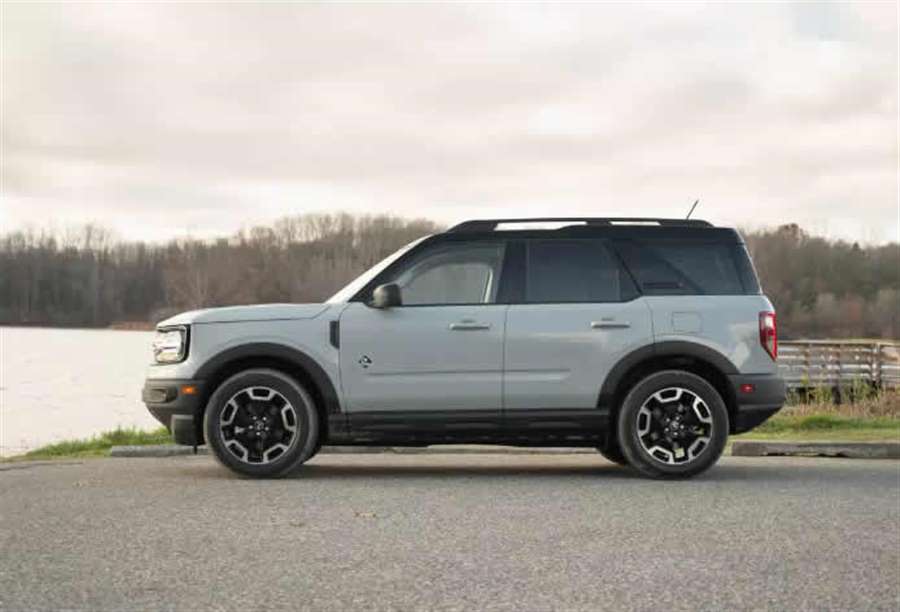
Yes, I know, we’re all very excited for the arrival of the 2021 Ford Bronco, and everyone’s just abuzz about it: How well does it go off-road? Is it better than a Wrangler? Is the top easy to take down? How heavy are the removable doors? And so on. But what we should keep in mind is that Ford introduced not one but two SUVs under the Bronco name: the “big” Bronco and this one, the 2021 Ford Bronco Sport.
Here’s where the off-road purists start their lament: “Oh, that’s not a proper off-road vehicle,” they’ll say. “That’s just a Ford Escape with some off-road bits stapled to it.” And while that’s not entirely inaccurate, it’s also not the whole story. Ford has made a lot of hay about how the big Bronco is super-capable off-road, with tons of technology, best-in-class specs and some genuine trail cred. Then the company pasted that “Bronco” name onto the front of this smaller, compact SUV — and that should also tell you something about it.
The compact Bronco Sport does indeed share some of its hidden bits with the Escape (as well as the no-longer-sold-in-the-U.S. Focus sedan), but those are common structural parts no buyer will ever see, like the expensive-to-make firewall stamping and other underbody elements. The Bronco Sport is shorter than the Escape both in wheelbase and in overall length, sporting very different dimensions aimed at creating a highly capable off-road SUV meant to challenge the Jeep Cherokee. Along the way, Ford has thoroughly engineered the SUV to do things that will surprise a lot of off-road purists who think only a body-on-frame, super-lifted, rear-wheel-drive, truck-based monster can successfully conquer trails. After spending an afternoon in the Bronco Sport with free run over a challenging off-road park, I’m here to tell you it may be a better choice for an everyday off-roader than the big Bronco itself.
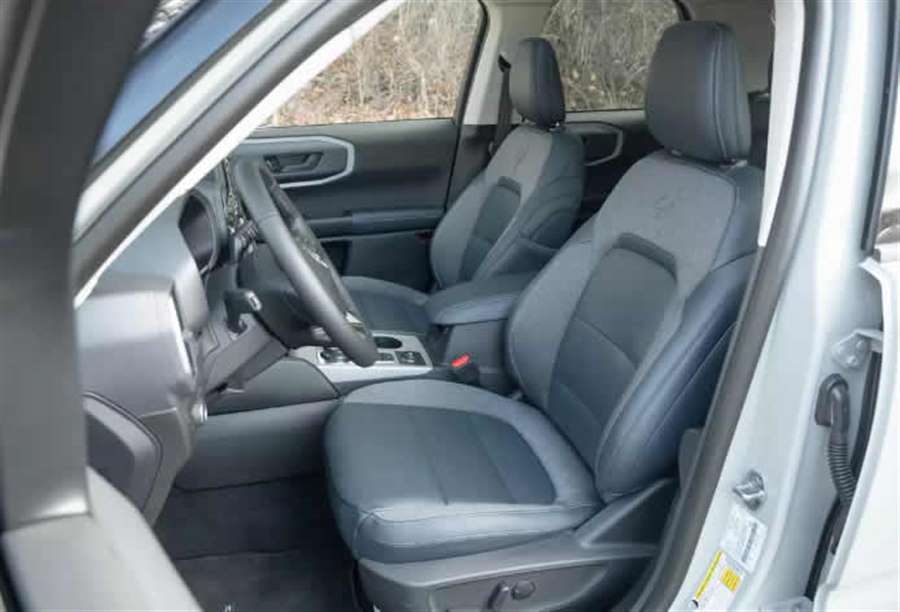
Let’s start with a quick discussion of the various types of Bronco Sport you can buy, as Ford has created five trim levels, each providing a different kind of experience. In order of increasing content, they are Base, Big Bend, Outer Banks, Badlands and First Edition.
The Base trim is exactly that: a no-frills compact SUV featuring everything you need for adventure, including a peppy turbocharged 1.5-liter three-cylinder engine cranking out 181 horsepower and 190 pounds-feet of torque. It’s mated to a standard eight-speed automatic transmission that sends power to all four wheels. It has all the basics, like an 8-inch display screen, 17-inch wheels, an electronic Terrain Management System with Ford’s “G.O.A.T. Modes” (stands for “Goes Over Any Type of Terrain”), Ford Co-Pilot360 safety systems and more. Choose the Big Bend model and you’ll get some additional content, including two-way manually folding rear seats, privacy glass, push-button start, rubberized cargo floors and some other nice-to-have bits and pieces. The Outer Banks model is meant to be the nicer “luxury” version, with a leather interior, power seats, a digital gauge cluster and bigger 18-inch wheels. In “Jeep-speak,” you’d call this one the Sahara trim.
Then we get to the top off-road model, the Badlands. It swaps out the turbo 1.5-liter engine for a 2.0-liter one that makes 250 hp and 277 pounds-feet of torque. It gets a 1-inch lift kit, a special off-road suspension, off-road tires, a more advanced four-wheel-drive system with a twin-clutch rear-drive differential, seven G.O.A.T. modes instead of five, underbody bash plates, tow hooks, a front trail camera and more. There’s also an even more exclusive First Edition model, but it’s already sold out, so I won’t bother with that one. Instead, let’s focus a lot of our attention on the Badlands model — which is deserving of that attention because it’s extraordinarily impressive.
Out On the Road
The first thing you’ll notice about the Bronco Sport if you drive any version of it is that it feels like a bigger SUV than it is. The hood feels almost horizontal, and it’s big, square and very traditional-feeling, creating a similar sensation to sitting in the bigger Bronco. It’s pleasingly boxy, helping you see the corners of the SUV — useful in off-road situations or parking lot maneuvers. That formidable hood is the only thing that feels big about the Bronco Sport, though, as the rest of its dynamics show it to be a nimble, tight-handling little SUV that’s as good to drive on the street as it is in the dirt.
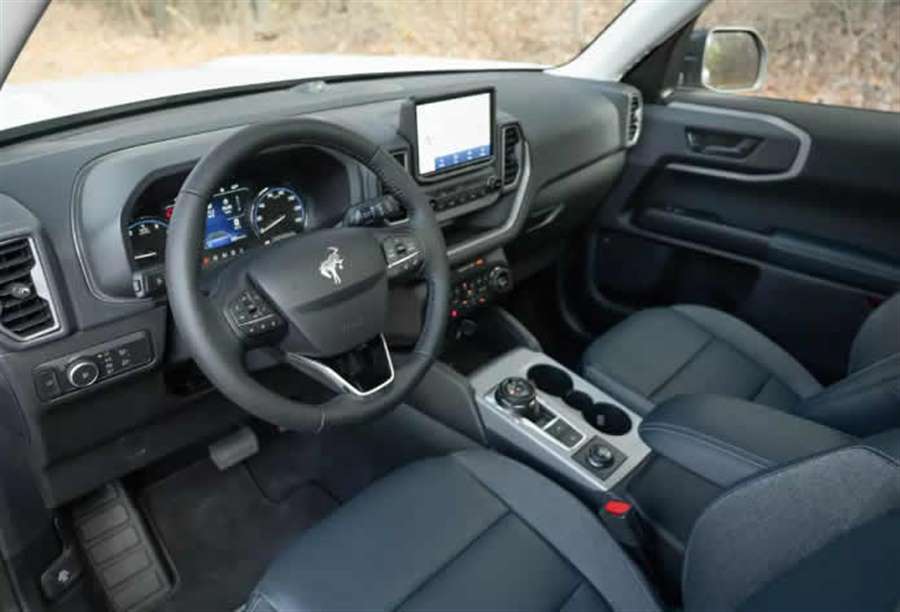
The turbocharged 1.5-liter engine that comes in the vast majority of Bronco Sports is torquey, peppy and has plenty of grunt for around-town driving. Slip the G.O.A.T. mode selector into Sport and it becomes truly quick, with the eight-speed automatic transmission keeping things on boil by maintaining a lower gear than it would in the normal driving mode. It does tend to run out of steam at higher speeds, however, so passing maneuvers on highways might require a little planning, but it never feels slow or ponderous in its operation; for the vast majority of users, it’s going to be plenty of motor. The optional turbo 2.0-liter engine takes things to the next level: Available only in the top Badlands and sold-out First Edition trim levels, you’ll pay for the privilege of extra power, but it does show noticeably better performance on acceleration. Honestly, though, I’d be perfectly happy with the 1.5-liter engine; the 2.0-liter seems more like a perk than a benefit.
The Bronco Sport handles well, too — despite fairly highly boosted steering feel — and definitely features some different characteristics depending on which trim level you choose. Lesser trim levels with their all-terrain tires feel a bit tighter, while the Badlands and its softer, lifted suspension and dedicated off-road tires feels a bit floatier. The Badlands is also a bit louder since its knobbier tires send more road noise into the cabin; given the Bronco Sport’s off-road intentions, though, this is neither unexpected nor unwelcome. The overall on-road driving experience is impressive, combining carlike handling with easy operation, a tall driving position, excellent outward visibility and the traditional crossover characteristics that have made the body style so popular.
Deep in the Woods
The purpose of a Bronco Sport is not commuting; for that, Ford has the perfectly capable Escape. The Bronco Sport’s on-road civility means you can commute in it just fine, but it has the equipment, technology and engineering to be a highly capable off-road machine. Ford likes to bill the Bronco Sport as having a different mission than the big Bronco. The Sport is for getting you to basecamp with all your stuff so you can do whatever you came to do, whether hiking or kayaking or mountain biking. The big Bronco is meant to go further — to be the very reason you’re out in the wilderness, the activity you went off-road for. If that’s the case, though, Ford has made the Bronco Sport far more capable than it needs to be.
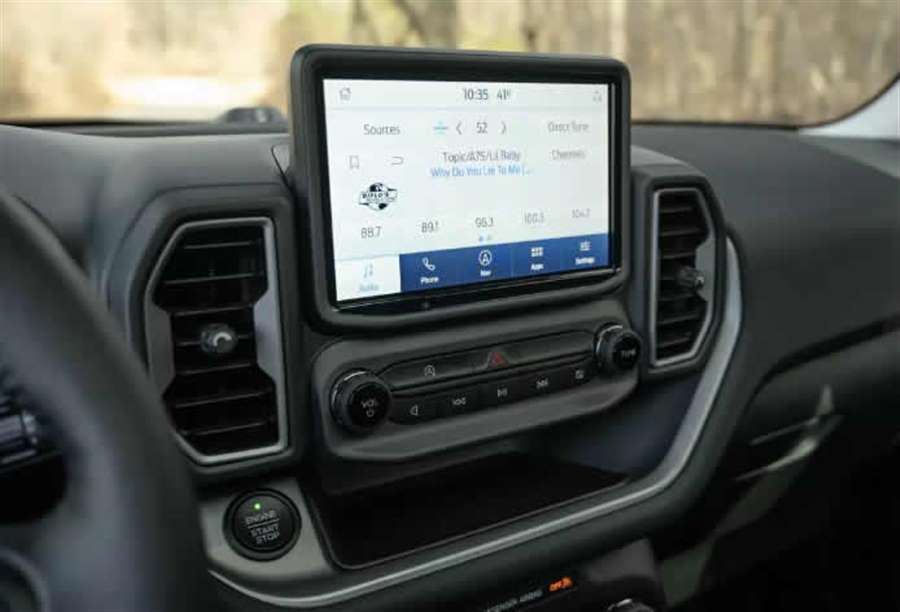
My afternoon with a Bronco Sport at the Holly Oaks Off-Road Vehicle Park in Southeast Michigan saw me take a Badlands over slippery rock faces, through high-speed sand pits, around tight wooded trails and down steep declines, all meant to be challenging for any SUV — and likely impossible for the vast majority of cute-ute crossovers. The Bronco Sport not only handled such obstacles with ease, it did so with a level of comfort that was absent in my previous ride-along in a big Bronco. Given its smaller dimensions that make it easier to shepherd through tight trails, one wonders if the Bronco Sport isn’t the better choice for a “casual” off-road adventurer, leaving the more expensive, heavier big Bronco for those who want the most hardcore experience they could have.
Ford makes it easy to take the Bronco Sport into the muck thanks to the use of its G.O.A.T. modes. The Badlands has seven of them, adding Mud/Ruts and Rock Crawl to the standard five of Normal, Eco, Sport, Slippery and Sand. You can lock the four-wheel drive yourself, but switching into the mode that matches your environment will do that for you as needed, along with making adjustments to things like electronic steering feedback, throttle input, transmission shift points, traction control and more.
This is where the budget Land Rover comparisons come in. The system feels similar to how the latest British-brand luxury SUVs handle a lot of their off-road duties. The Bronco Sport will match a lot of the abilities of a vehicle like a Land Rover Discovery Sport, and it comes with the added perk of a slew of more than 100 factory-approved accessories, ranging from lights to racks to rooftop tents that can be ordered along with the SUV at the point of purchase. Using their Terrain Response system, Land Rovers adjust a lot of the same systems Ford does with its G.O.A.T. modes, allowing for a multiple-personality SUV that’s perfectly comfortable on-road and perfectly capable off-road. Simply drive off the pavement, switch into the mode that best describes what you’re about to drive over, and away you go — no fuss, no muss. It works exceptionally well and will allow a lot of less experienced off-roaders to do things that require a bit of training in, say, a Jeep Wrangler, in which you need to know how to adjust most systems and equipment yourself. To Jeep’s credit, the Cherokee has a similar system that also adjusts various vehicle systems to the conditions; a full-on matchup between the Bronco Sport and Jeep Cherokee is an absolute must, and soon.
Getting There Is Half the Fun (Possibly Three-Quarters of It)
In addition to crafting a massively capable budget Land Rover out of a Ford Escape, the Blue Oval has also added a considerable dash of style and utility to the interior. The Bronco Sport’s interior is completely different from the Escape’s, with a more industrial, rugged look to the shapes and surfaces that’s entirely in keeping with its family lineage to the Bronco line. There’s even an available rubberized floor covering in case you want something that’s easy to wipe out. It’s also notable that Ford has introduced to the Bronco Sport interior color that’s missing from a lot of SUVs these days — shades of blue, bronze, silver and orange that are all a welcome departure from the dull greige in a lot of competitor vehicles.
While the interior is good, it’s also not perfect. As is the case with a lot of Fords, the seats feel smaller than they should be and are shaped in uncomfortable ways. The Badlands model’s optional leather-covered chairs had bottom cushions with an odd dome that made me feel like I was sitting on an exercise ball. The backseat is not terribly generous in the legroom department — likely a function of losing some wheelbase versus the Escape. Headroom isn’t an issue thanks to the Bronco Sport’s safari-style roof and upright, boxy styling. The cargo area looks plentiful, but Ford has not yet published dimensions for the Bronco Sport, so comparisons with other compact SUVs are difficult at this time. Of note here is the standard flip-up glass rear window, which is a feature you don’t often see anymore but which is useful for just popping something into the cargo area without having to open the entire hatch (and maybe having things spill out).
On the technology front, the Bronco Sport has all the modern amenities and safety conveniences you might expect from a new Ford, plus maybe one or two tech bits that seem a little odd. First, Ford Co-Pilot360 is standard, bringing things like automatic emergency braking with pedestrian detection, forward collision warning, blind spot warning, rear cross-traffic alert, lane keep assist, auto high beams and a backup camera. Upgrade to Co-Pilot360 Plus and you’ll also get adaptive cruise control with lane-centering, evasive steering assist and more.
The multimedia system in the Bronco Sport is curiously not the latest Sync 4 system you can get in the new 2021 Ford F-150, but rather the older Sync 3 system that runs on an 8-inch touchscreen. It’s a little small in terms of display size — most new competitors have larger screens — but it’s as large and up-to-date as the system in the Escape. It also has something that Sync 4 doesn’t have: a “home” button, which we never thought we’d miss until Ford eliminated it in the F-150. The system still works fine, syncing up with a smartphone without issue, and provides Apple CarPlay or Android Auto in case you don’t want to use the native Ford systems.
Source: cars.com

